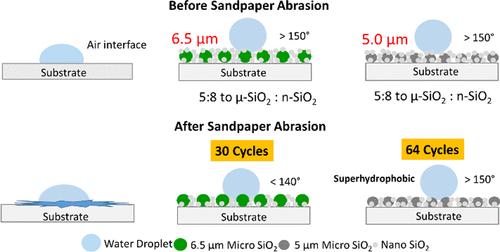基于绿色化学的纳米和微sio2超疏水涂层具有强大的防污和防腐性能
IF 8.2
2区 材料科学
Q1 MATERIALS SCIENCE, MULTIDISCIPLINARY
引用次数: 0
摘要
随着能源需求的增加,对具有特殊超疏水性能的涂层材料的需求大幅增长。然而,氟化化合物、溶剂和聚合物基合成材料的广泛使用导致微塑料和污染物水平升高。本研究采用自固化、无溶剂、可回收的聚酯多元醇高分子材料,结合(5 μm和6.5 μm)微米和纳米SiO2 (μ-SiO2和n-SiO2)颗粒,制备了接触角大于170°、滚脱角小的超疏水涂层。它们被用于自清洁、防污和防腐目的,并在热水、蒸汽和超声波中测试了稳定性。与n-SiO2混合后的μ-SiO2颗粒均表现出优异的防污性能。此外,5 μm SiO2掺杂n-SiO2涂层在62次循环砂纸磨损试验中表现出更高的耐磨性,接触角保持在150°以上,而6.5 μm SiO2涂层在30次循环后接触角较低。这些结果表明,由于6.5 μm SiO2的不规则粗糙度,其对外力的阻力较小。然而,在压力较小的情况下,例如水滴测试,这两种涂层都可以轻松承受3000滴。此外,电化学极化曲线分析、交流阻抗分析和海水浸泡试验证实了超疏水材料具有良好的耐腐蚀性。本文章由计算机程序翻译,如有差异,请以英文原文为准。

Nano- and Micro-SiO2 With Integrated Green Chemistry-Based Superhydrophobic Coating for Robust Antifouling and Anticorrosion Properties
With increasing energy demands, the need for coating materials with exceptional superhydrophobic properties has grown substantially. However, the widespread use of fluorinated compounds, solvents, and polymer-based synthetic materials has led to heightened levels of microplastics and pollutants. Here, we used a self-curing, solvent-free, and recyclable polyester polyol polymer material combined with (5 and 6.5 μm) micro- and nanosized SiO2 (μ-SiO2 and n-SiO2) particles to create superhydrophobic coatings with contact angles above 170° and low roll-off angle. They were applied for self-cleaning, antifouling, and anticorrosion purposes and tested for stability in hot water, steam, and ultrasound. Both μ-SiO2 particles mixed with n-SiO2 exhibited excellent improvement in antifouling properties. Furthermore, 5 μm SiO2 incorporated with n-SiO2 demonstrated significantly higher resistance in a 62-cycle sandpaper abrasion test and maintained a contact angle above 150°, whereas this angle was lower for the 6.5 μm SiO2 coating after 30 cycles. These results suggest that 6.5 μm SiO2 offers less resistance to applied force due to its irregular roughness. However, in scenarios with lower forces, such as water drop tests, both coatings easily withstand a drop count of 3000. Additionally, electrochemical polarization curve analysis, AC impedance analysis, and seawater immersion tests confirmed the robust corrosion resistance of the superhydrophobic material.
求助全文
通过发布文献求助,成功后即可免费获取论文全文。
去求助
来源期刊

ACS Applied Materials & Interfaces
工程技术-材料科学:综合
CiteScore
16.00
自引率
6.30%
发文量
4978
审稿时长
1.8 months
期刊介绍:
ACS Applied Materials & Interfaces is a leading interdisciplinary journal that brings together chemists, engineers, physicists, and biologists to explore the development and utilization of newly-discovered materials and interfacial processes for specific applications. Our journal has experienced remarkable growth since its establishment in 2009, both in terms of the number of articles published and the impact of the research showcased. We are proud to foster a truly global community, with the majority of published articles originating from outside the United States, reflecting the rapid growth of applied research worldwide.
 求助内容:
求助内容: 应助结果提醒方式:
应助结果提醒方式:


